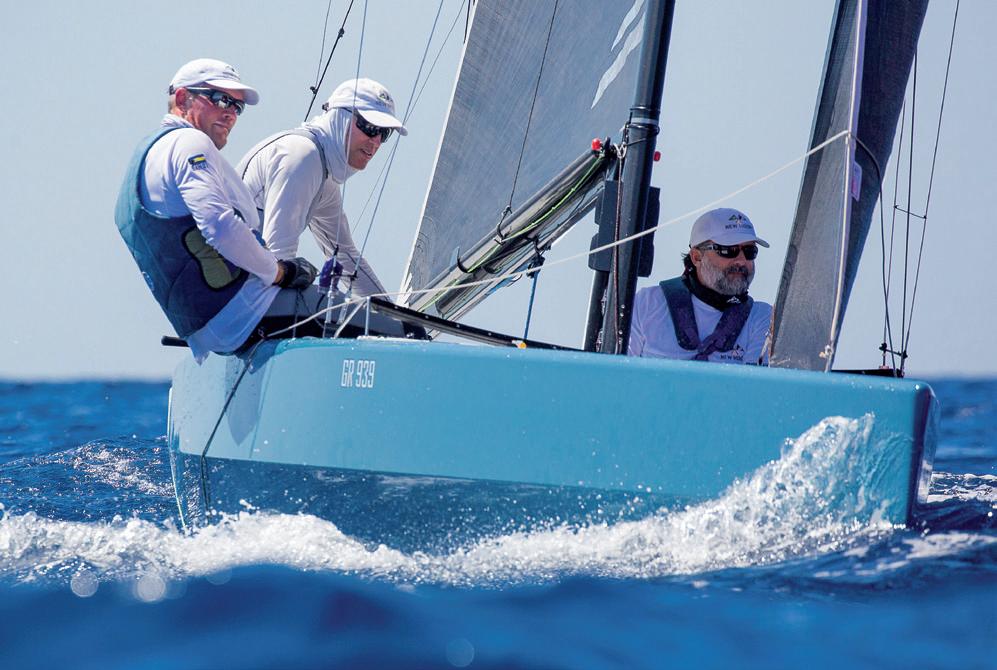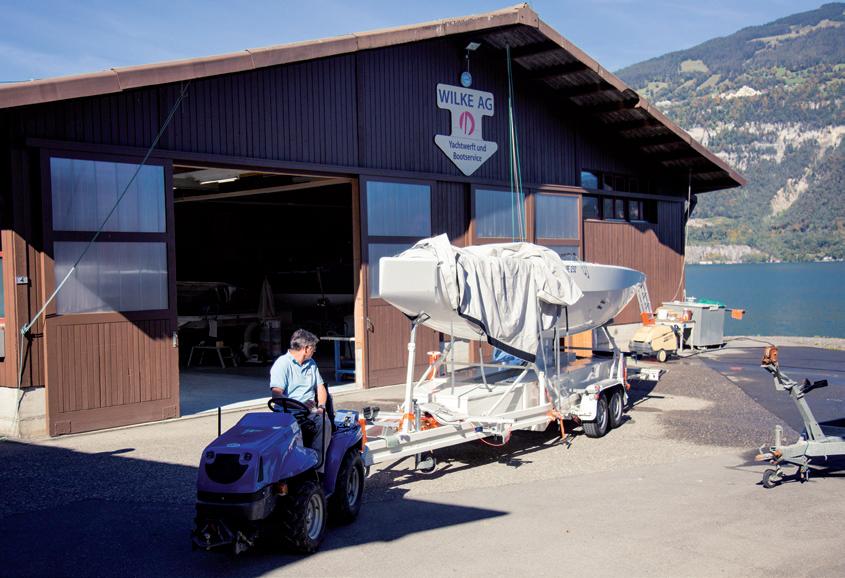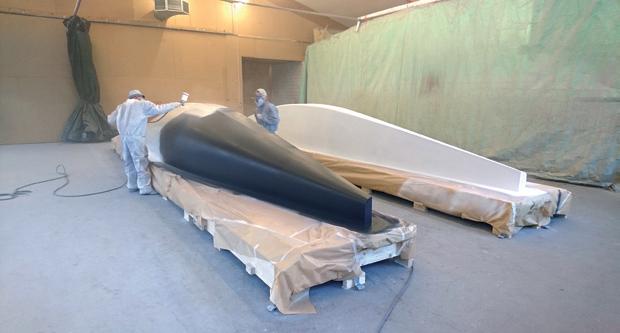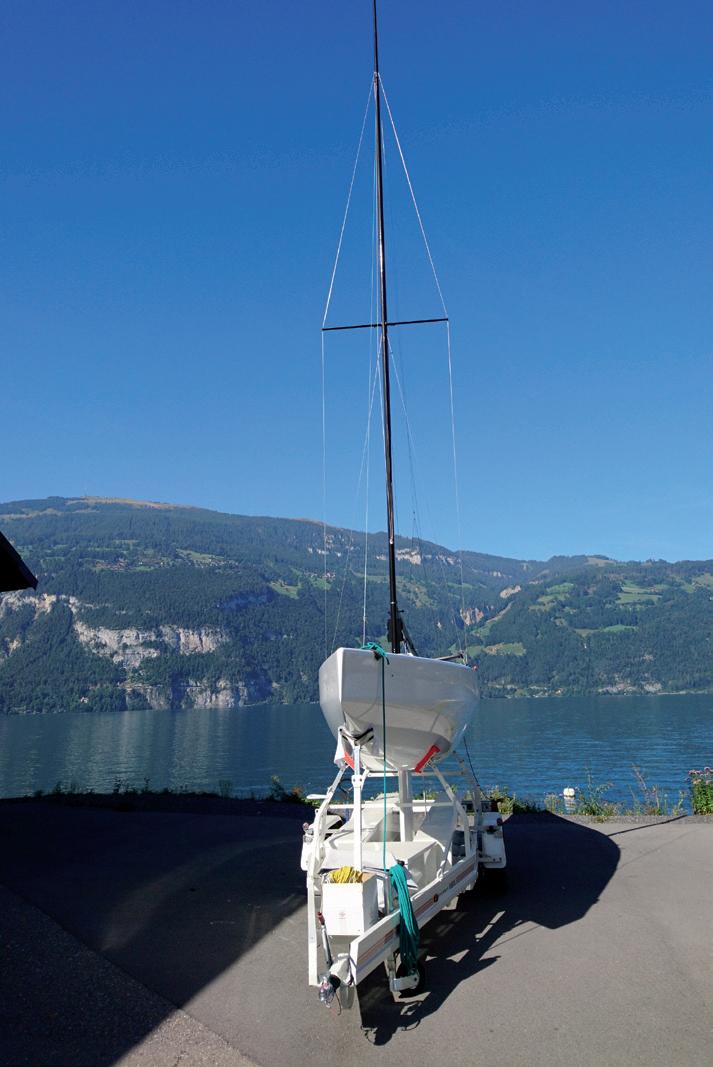
13 minute read
Christof Wilke – An open mind and a lot of luck
An open mind and a lot of luck
over the lAst 30 yeArs the WilKE yArd, by the shores of lAke thun in switzerlAnd, hAs undoubtedly Produced the most successful 5.5 metres in the world. they show no sign of slowing uP with A new design hitting the wAter in 2020.
Advertisement
Over the past three decades, the name of Christof wilke has become synonymous with the 5.5 Metre Class. He built his first 5.5 in 1993, and 28 years later has now built more than 35. At the top of the fleet, it is almost a one-design class with wilke built boats having won every world championship since 1999, and in 2020 the yard launched its latest 5.5 metre design.
His energy and enthusiasm for the boat is readily apparent and has driven growth in the class. His yard is located on the shores of Lake Thun, overlooked by the towering monsters Jungfrau and the Eiger, and the Thunersee Yachtclub further up the lake now boasts one of the largest 5.5 Metre fleets in the world. He sums up his approach to the 5.5 Metre very succinctly. “I came into the class with no preconceptions and a fresh mind to try something different. I had an open mind and lots of luck.”
BoAtyArd
Christof Wilke was born in 1960 and after high school he obtained his engineering degree in boat building and construction. In 1986, together with his wife Yvonne, he founded his own company on the banks of Lake Thun. The yard specialised in building extreme and fast yacht prototypes for the lakes, as well as providing maintenance and wintering services to hundreds of local boaters. In 1993 Wilke moved his yard to the southern end of the Lake Thun at Leissingen, near Interlaken. The yard has capacity to store 150 boats of all sizes undercover and outside. Wintering services, painting
Top: Momo, SUI 229, at the Europeans in Sanremo left: New Moon II in Sanremo The sharper chines are quite noticeable on the new boats right: Christof Wilke Top right: Getting a 5.5 Metre ready for competition at the yard in Leissingen


and repair are available for all types of boats made of wood, fibreglass, composite and carbon fibre or aluminium. The yard has its own crane next to the water, and the perfectly isolated building, oven/ cabins with temperature and negative pressure control secure the best polymerisation for carbon and glassfibres and resin. Epoxy and carbon are the preferred materials in the yard.
Located in the Bernese Oberland in the Swiss Alps, the Wilke boatyard is, in terms of production, the fourth largest yard in Switzerland. As well as the worldwide specialist for 5.5 Metres, the yard produces customised ‘one-off’ carbon yachts, Star boats, and the Wilke Finn and Wilke Finn carbon mast.
With the Finn wing carbon mast, Christof Wilke and his team became a major player in the global market. For more than 20 years the Wilke Finn mast has been the mast of choice for many Olympic and world champions. Production began in 2000 with immediate success and European championship gold and Olympic bronze. Since then they have become the most successful carbon Finn masts with four Olympic gold medals. The masts are in constant evolution and each year the yard uses more than one tonne of carbon fibre, delivering carbon masts to Finn sailors at all levels.
The yard also produced many Finns and Star boats, while the development of larger boats such as Wild Lady, a 49 feet racing yacht, remains a focus. Wilke 49, ‘Wild Lady’ with its impressive keel, has won long distances races on Lake Garda as well as on the Lake Constance. The Wilke 26 is another Wilke keel yacht produced in small numbers.
Quality and performance are the drivers for Christof Wilke, using only the best materials, for high quality products. He leads the company of 10 to 15 people as Chief Developer, with a high motivation to quality and high tech.
New and future projects are never far away for Christof Wilke and his team. In 2020 he embarked on an ambitious new 6 Metre project, starting from nothing. To relax and ‘think-tank’ new ideas you can find him on his snowboard running very fast down the Jungfrau slopes. Speed is his driver and motivation.
First FiVes
Christof first got involved in the 5.5 Metre class in 1993.
“I had possibility to sail one for the first time in Cannes at the Europeans in 1993 and it was my first contact with the class. It was so sexy, and I was keen to build one. We found someone from the lake here who was ready to build with me and we started a project for two boats.”
These were SUI 187 and SUI 188.
“SUI 187 is the boat that John Bacon is now sailing – Kuring-gai. That was the first boat I built and he is supper happy with that.”
Ku-ring-gai has won the Evolution trophies at the World Championship over the past two years.
“We were a little bit lucky with this because the first boat we built was quick and after two or three seasons they had good results and then more people starting asking for them.”
Since his first 5.5 Metre, Christof has used the design services of Sébastian Schmidt, from Geneva.
“He helps to develop the hull, while I am doing technical stuff such as scantlings, laminating plans and cockpit design.”
While the boats are designed on a computer, “It is not just about the computer programme, you need a guy with feeling. The programme can make a really smooth hull, but without feeling, like in waves, and with dynamics, the computer alone is not able to make the best design – it’s just a tool.
“For the structural engineering for the 5.5 Metre like twist and suppleness, I work with design office specialised in this in France.”
He is also undertaking a 6 Metre, creating a design and new moulds. For this project, Christof is working with the yacht designers at Judel-Vrolijk in Germany, famous for TP52, Maxi 72, and various Wallys.
“It is huge job to build a 6 Metre from scratch.”
For any of these boats, “You can’t do everything alone. It’s impossible. The development is going higher and higher and the



The new plugs are prepared and finished before the two moulds are taken. Finally it is cleaned and polished ready for the first build.


space to win is getting smaller and smaller, so it’s a lot of work and you need specialists.”
somethinG diFFerent?
Though they had been tried before, Wilke was the first 5.5 Metre boatbuilder to develop trim tabs with winglets.
“They are limited by the rules, so we went to the maximum to try and get the best possible solution.
“We started with an open book thinking we can try anything.
“That was really the first trim tab keel that was actually starting to work. It was certainly not perfect, but it was the first. From that point we started to develop even better and better keels.”
“We were new into the class with no hang ups about the old ways of doing things. So we had an open mind and took some risks and I think there was a lot of luck, but finally we got a boat that was really quick and fast in all conditions.
“That’s the beginning of the journey that started a new generation in the class.
“We were not alone at that time because there was also the Melges Works factory. They built a lot of 5.5 Metres. They had two generations of boats, first the one with the special keel and then the second generation was a modern boat designed by Doug Petersen. It was a super good boat and they are still sailing today in the Evolution class. They went really well, so we had to fight. “We had an idea to make a trim tab on the keel so we made a keel and the hull shape, and then cut a bit away. We started with what we felt was OK. But in light conditions and certain wave conditions it didn’t work, so and then we started to think, so we had to build a different profile so that if the tab has a certain angle it makes a smooth profile with the keel. “So it was a development step by step, trying to find a better angle between tab and the rudder. It was really new at the time. “There was a lot of small stuff but if you find a hundred small
left: Christof Wilke sailing with Jürg Menzi and Jürgen Eiermann on Lake Thun in October 2020 right: Looking south from the Wilke Yard, Ali Baba and Aspire wait for wind



The build process for SUI 229 Momo - The two sides are vacuum infused before being joined together. Below: Checking the weight of bare hull.


issues, in the end they all add up. We were always improving everything slowly.
“Other builders copied, but not immediately. Melges didn’t adapt. They stayed with old rudders and we were working on trim tabs, rudders, winglets on rudders, all kinds of stuff possible within the rules, and they just produced, produced, produced, but you can’t stop developing as it is a construction class.
“But of course there are different commercial interests. They were interested in a large number of builds, if possible all the same, because it was easier. We are a bit more specialised for custom building.”
The Wilke Yard in Switzerland has so far made about 35 5.5 Metres since production first started in 1993.
new mould For 2020
“The first boat we ever built was from a plug. And the second we cut at the transom and changed it. It was easy to change because it was wooden. Later we started to do the same with negative moulds like they did in the old days when they just cut the boat in half and made it wider or narrower. We did the same with our moulds for many years.”
“We built about 20 boats out of the last mould but it had had too many modifications over the years, so we decided to make a new one. The old one was recut at least seven times.
“So we built a brand new mould in 2019. So far we have built four boats out of it. So far it has no modifications. It still looks nice.”
The mould is split vertically rather than horizontally, with a join down the middle of the deck and along the keel.
“We can’t mould the joins properly the other way. This way, we can laminate the joints more properly. There are a lot of reinforcements on the side and on the bottom, and as we don’t have any connections here, so we can laminate it properly inside.
“We laminate both sides and then screw them together. There is much more material on the bottom than the sides, so it’s a good way to do the reinforcement and connection together. Then you put the cockpit in and it’s ready. We make our Stars in the same way.”
The plugs are made using a CNC cutter to ensure accuracy and symmetry. Wilke works with a partner in France for the keels and another in Germany for the moulds.
The new shape is very similar to the previous shape except it has straighter and smoother lines. However, “we wanted to increase the dynamical length of the boat. When the boat is heeling the waterline will be longer. That was the main goal.




Momo finally leaving the workshop, being weighed and then having the mast stepped.
“Under the water the shape is very similar but the chine is slightly sharper as the waterline is narrower. The actual volume is the same.”
The new boats also have very small inverse sheer. “The idea of the positive bend, and there are a lot of boats with positive bend and it’s a modern style, was to lift the middle part to have the mast slightly higher on the waterline.”
The decks include foam for strength, while the hull and topsides are just glass. Each side is infused and then they are joined together by bolting around the join. Then the join itself is laminated and reinforced and further infused. Before the cockpit tub is fitted, the measurer goes in and measures all the reinforcements.
Accuracy is a trademark of the Wilke yard, with pride taken in the construction and finish in every boat and mast. The boats are built by vacuum infusion and it accurate to within two percent. “We can calculate it to 100 kg of resin – plus or minus 2 kg.”
The boat is then weighed before the keel is moulded, and weighed again after the keel has been fitted. This is all carried out at the Wilke yard, including launching to check the waterline.
“The process is very complicated and time consuming. But the 5.5 Metre is a construction class so it is like this and you have to accept it.”
5.5 desiGn
“The 5.5 Metre rule allows quite a wide scope for development. For example, the weight range is from 1,750 kg up to a maximum of 2,050 kg.
“It is connected with sail area and waterline length and many other parameters, but we started making boats at 1,900 kg or a bit less and now we are up to 2,000 kg. We had one boat on maximum weight but it was no good. The magic weight for us is about 2,000 kg.
“We always try to have maximum sail area, and if you have light boats you have small sail area.
“We saw some development from other builders with very light boats which were good in light conditions, up to a maximum of 10 knots. But then game was over.
“We are going for all round boats that are fast in all conditions. We are maybe not super fast in the light or in super heavy but on average they are good. When sailors are going to events and studying the conditions they don’t have to worry about the conditions. They are able to perform whatever weather arrives.
“Of course there is a relation between wetted surface and centre of gravity but to achieve centre point of side force it is important to know how the trim tab works, but it’s the same for every boat. It’s no secret that every racing boatbuilder tries to group everything together to centre the weight and the same with sail area, trying to centre everything together. “The objective is also to go for structural integrity along with suppleness in the right areas.” The hulls need, “Fore and aft stiffness so the boat can take the forestay tension, athwartships stiffness so that the boat doesn’t buckle and then maximum twist longitudinally. And then suppleness in bow and stern sections to handle the waves downwind.”
three deCAdes
Over the last 30 years, the Wilke yard has undoubtedly produced the most successful 5.5 Metres in the world, and they show no sign of slowing up.











